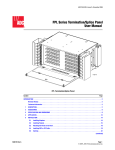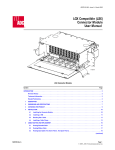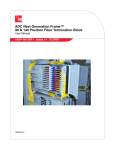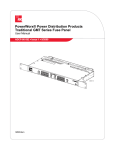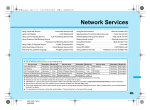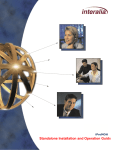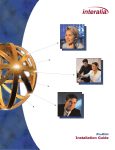Download LGX-Compatible (LSX) Preterminated Termination
Transcript
LGX®-Compatible (LSX) Preterminated Termination/Splice Panel With Pigtails User Manual ADCP-93-095 • Issue 2 • 9/2009 17521-A Content Page INTRODUCTION . . . . . . . . . . . . . . . . . . . . . . . . . . . . . . . . . . . . . . . . . . . . . . . . . . . . . . . . . . . . . . . . . . . . . . . . . . . . . 2 1 DESCRIPTION. . . . . . . . . . . . . . . . . . . . . . . . . . . . . . . . . . . . . . . . . . . . . . . . . . . . . . . . . . . . . . . . . . . . . . . . . . 2 2 DIMENSIONS . . . . . . . . . . . . . . . . . . . . . . . . . . . . . . . . . . . . . . . . . . . . . . . . . . . . . . . . . . . . . . . . . . . . . . . . . . 6 3 SPECIFICATIONS. . . . . . . . . . . . . . . . . . . . . . . . . . . . . . . . . . . . . . . . . . . . . . . . . . . . . . . . . . . . . . . . . . . . . . . . 8 4 UNPACKING THE PRODUCT . . . . . . . . . . . . . . . . . . . . . . . . . . . . . . . . . . . . . . . . . . . . . . . . . . . . . . . . . . . . . . . . 9 5 INSTALLATION . . . . . . . . . . . . . . . . . . . . . . . . . . . . . . . . . . . . . . . . . . . . . . . . . . . . . . . . . . . . . . . . . . . . . . . . . 9 6 5.1 Installing the Combination Module . . . . . . . . . . . . . . . . . . . . . . . . . . . . . . . . . . . . . . . . . . . . . . . . . . . . . 9 5.2 Grounding an Armored Cable . . . . . . . . . . . . . . . . . . . . . . . . . . . . . . . . . . . . . . . . . . . . . . . . . . . . . . . . 10 5.3 Breaking Out a Cable for Splicing . . . . . . . . . . . . . . . . . . . . . . . . . . . . . . . . . . . . . . . . . . . . . . . . . . . . . 11 5.4 Installing a Cable Clamp . . . . . . . . . . . . . . . . . . . . . . . . . . . . . . . . . . . . . . . . . . . . . . . . . . . . . . . . . . . 12 5.5 Feeder Cable Routing . . . . . . . . . . . . . . . . . . . . . . . . . . . . . . . . . . . . . . . . . . . . . . . . . . . . . . . . . . . . . 15 PATCH CORD ROUTING . . . . . . . . . . . . . . . . . . . . . . . . . . . . . . . . . . . . . . . . . . . . . . . . . . . . . . . . . . . . . . . . . . 19 6.1 Patch Cord Routing Within the LSX Module . . . . . . . . . . . . . . . . . . . . . . . . . . . . . . . . . . . . . . . . . . . . . . . 19 6.2.1 Cross-Connecting Within a Stand-Alone Bay . . . . . . . . . . . . . . . . . . . . . . . . . . . . . . . . . . . . . . . 20 6.2.2 Cross-Connecting Between Adjacent Bays. . . . . . . . . . . . . . . . . . . . . . . . . . . . . . . . . . . . . . . . . 22 6.2.3 Cross-Connecting to Non-Adjacent Bays . . . . . . . . . . . . . . . . . . . . . . . . . . . . . . . . . . . . . . . . . . 23 6.2.4 Routing Patch Cords Starting in the Lower Raceway. . . . . . . . . . . . . . . . . . . . . . . . . . . . . . . . . . 24 (Continued) 1450382 Rev A Page 1 © 2009, ADC Telecommunications, Inc. ADCP-93-095 • Issue 2 • 9/2009 Content (continued) 7 8 Page 6.2 Routing Patch Cords on the LGX Bay . . . . . . . . . . . . . . . . . . . . . . . . . . . . . . . . . . . . . . . . . . . . . . . . . . . 20 6.3 Mounting 144-Position Modules Adjacent to 72 or 96 Position Modules . . . . . . . . . . . . . . . . . . . . . . . . . . . 28 OPERATION . . . . . . . . . . . . . . . . . . . . . . . . . . . . . . . . . . . . . . . . . . . . . . . . . . . . . . . . . . . . . . . . . . . . . . . . . . 28 7.1 Removing a Cover for Easier Access . . . . . . . . . . . . . . . . . . . . . . . . . . . . . . . . . . . . . . . . . . . . . . . . . . . 28 7.2 Patching and Testing . . . . . . . . . . . . . . . . . . . . . . . . . . . . . . . . . . . . . . . . . . . . . . . . . . . . . . . . . . . . . . 28 CUSTOMER INFORMATION AND ASSISTANCE . . . . . . . . . . . . . . . . . . . . . . . . . . . . . . . . . . . . . . . . . . . . . . . . . . . 30 INTRODUCTION This user manual describes the ADC LGX Compatible (LSX) Preterminated Termination/ Splice Panel With Pigtails, and provides instructions for installation and operation of this product. The panel is designed to be mounted on either a 19-inch (48.26 cm) or 23-inch (58.42 cm) Lucent (LGX) compatible rack. It is designed for use with stranded or ribbon-construction cable, which may be Outside Plant (OSP) or Intra Facility Cable (IFC). Revision History quad cables and patch cord routing ISSUE DATE Issue 1 05/2002 Original. REASON FOR CHANGE Issue 2 09/2009 Original. Trademark Information ADC is a registered trademark of ADC Telecommunications, Inc. LGX is a registered trademark of Lucent Technologies. Related Publications Title LGX-Compatible (LSX) 288-Position Termination/Splice Panel User Manual LGX-Compatible (LSX) Connector Module User Manual Armored Plenum Compact Building Cable Ground Clamp Kit (GND-STPKIT) Installation Instructions 1 ADCP Number 93-103 93-089 90-382 DESCRIPTION The LSX Preterminated Termination/Splice Panel With Pigtails is an LGX style, rack-mounted panel that provides a splicing transition between one or more fiber optic cables and a termination bulkhead for fiber optic patch cords. Page 2 © 2009, ADC Telecommunications, Inc. ADCP-93-095 • Issue 2 • 9/2009 In a typical application, the LSX panel serves as a splicing and distribution point to transition from Outside Plant (OSP) or Intra Facility Cable (IFC) to inbuilding circuits connected to with patch cords. The panel may be used in either an interconnect or cross-connect configuration, and in either singlemode or multimode applications. Figure 1 summarizes the functional components of the LSX termination panel. As shown, an OSP or IFC cable is routed through the panel to the splice area access door, which serves as a splice deck. On the splice area rear access door, located on the rear of the panel, the component fibers are spliced to the internal pigtails. The factory-terminated internal pigtails transition to the bulkhead, located on the front of the panel. Patch cords installed from the front side of the panel provide the connection to fiber optic terminal equipment. MASS FUSION SPLICE CHIP SPLICE AREA ACCESS DOOR OSP OR IFC CABLE INTERNAL PIGTAILS BULKHEAD FOR PATCH CORD TERMINATION 17530-A Figure 1. Functional Components of LSX Preterminated Termination/Splice Panel (Cut-Away Top View) Page 3 © 2009, ADC Telecommunications, Inc. ADCP-93-095 • Issue 2 • 9/2009 The LSX panel is shipped with pre-terminated, factory-installed ribbon or stranded pigtails. The panel is available in five chassis heights with different numbers of termination positions, as follows: 1.75-inch high with 12 or 24 termination positions; 3.5-inch high with 48 termination positions; 7-inch high with 72 or 96 positions; 9-inch high with 144 positions; and 11-inch high with 288 positions (documented in a separate manual). Figure 2 shows the main external features of the 7-inch high panel. The 1.75-inch, 3.5-inch, and 9-inch high panels have analogous features. LGX COMPATIBLE CHASSIS BULKHEAD CONNECTOR PACK SPLICE AREA ACCESS DOOR MOUNTING BRACKET PATCH CORD GUIDE REMOVABLE FRONT COVER PATCH CORD DESIGNATION CARD REMOVABLE RADIUS LIMITERS 17523-A Figure 2. Main External Features of 7-Inch High LSX Termination/Splice Panel (Front View) The features shown are as follows (see Figure 2): • LGX-Compatible Chassis—is of solid metal construction and painted white. Nine 7-inch chassis or seven 9-inch chassis may be installed on an LGX frame. • Bulkhead—holds the pass-through adapters that provide the physical interface between the connector ends of internal pigtails and patch cords installed on the bulkhead. • Adapter Pack—6-, 8-, 12- or 24-pack depending on model; mounts in the bulkhead providing one column of adapters/connectors for terminating patch cords. Connector types available include singlemode USC, ASC, and UFC, and multimode SC. • Patch Cord Guides—provide cable management in routing patch cords. • Removable Front Cover—provides unimpeded access for installation of patch cords. • Patch Cord Designation Card—is used to record patch cord usage. • Removable Radius Limiter—provides bend radius protection for the fibers. Page 4 © 2009, ADC Telecommunications, Inc. ADCP-93-095 • Issue 2 • 9/2009 • Mounting Brackets—may be oriented for either 19-inch or 23-inch rack mount. Every LSX Termination/Splice Panel has a rear splice area such as shown in Figure 3 for the 7inch panel. The other height panels have analogous features. COVER WING NUT RIBBON FANOUT BRACKET CABLE RING (TYPICAL) OSP OR IFC CABLE CLAMP KURLEY LOCK (TYPICAL) SPLICE STORAGE SPOOL 17531-A MASS FUSION SPLICE CHIP SPLICE AREA ACCESS DOOR Figure 3. LSX Termination/Splice Panel (Rear View) The main features in the rear splice area are as follows: • OSP or IFC Cable Clamp—secures cable to chassis. • Kurley Locks—route and secure cable fibers and internal pigtails. • Splice Storage Spools—provides service loop storage for cable fibers and pigtails. • Mass Fusion Splice Chip—splices 24 fiber/pigtail interfaces. • Splice Area Access Door—folds down providing a horizontal splice deck. • Cable Ring—routes and secures cable on entry into splice area. • Ribbon Fanout Bracket—holds one stack of four ribbon fanout chips (if ribbon rather than stranded pigtails are present). • Wing Nut—secures the cover (next item) to hold it in place. • Cover—protects splices once completed. Each panel is shipped with a cable clamp. Page 5 © 2009, ADC Telecommunications, Inc. ADCP-93-095 • Issue 2 • 9/2009 2 DIMENSIONS Figure 4 shows dimensions for the most common chassis heights, 7-inch and 9-inch. Figure 5 shows dimensions for 1.75-inch high panel. Figure 6 shows the 3.75-inch high panel. 14.84 IN. (37.7 CM) 15.0 IN. (38.1 CM) 7.53 IN. (19.1 CM) 5.0 IN. (12.7 CM) TOP VIEW 16.84 IN. (42.8 CM) 22.15 (56.3 CM) 23-IN. RACK MOUNT (58.4 CM) 18.15 (46.1 CM) 19-IN. RACK MOUNT (48.3 CM) 1.0 IN. (2.5 CM) 2.0 IN. (5.1 CM) 1 1.0 IN. (2.5 CM) FRONT VIEW 1 7.0 IN. (17.8 CM) HEIGHT ON 72 OR 96 POSITION MODULES OR 9.0 (22.9 CM) HEIGHT ON 144 POSITION MODULES. Figure 4. Dimensions for 7-Inch and 9-Inch High Panel Page 6 © 2009, ADC Telecommunications, Inc. 17524-A ADCP-93-095 • Issue 2 • 9/2009 12.0 IN. (30.5 CM) TOP VIEW 5.0 IN. (12.7 CM) 16.84 IN. (42.8 CM) FRONT VIEW 19.33 (49.1 CM) 19-IN. RACK MOUNT (48.26 CM) 1.73 IN. (4.4 CM) 23499-A Figure 5. Dimensions for 1.75-inch High Panel TOP VIEW 12.0 IN. (30.5 CM) 5.0 IN. (12.7 CM) 16.84 IN. (42.8 CM) FRONT VIEW 19.33 (49.1 CM) 19-IN. RACK MOUNT (48.26 CM) 23500-A 5.23 IN. (13.3 CM) Figure 6. Dimensions for 3.50-inch High Panel Page 7 © 2009, ADC Telecommunications, Inc. ADCP-93-095 • Issue 2 • 9/2009 3 SPECIFICATIONS Table 1 lists specifications for the LSX panel. Table 1. LSX Combination Module Specifications PARAMETER SPECIFICATION REMARKS General Color Putty white Rack mounting 19- or 23-inch Connector Types Singlemode ASC, USC, UFC Multimode USC EIA or WECO hole spacing 7-Inch High Panel Number of Terminations 72 or 96 Dimensions (HxWxD) 7.0 x 17.0 x 12.0 inches (17.8 x 435 x 281.7 mm) Weight 25 lbs. (11.34 kg) See Figure 4 9-Inch High Panel Number of Terminations 144 Dimensions (HxWxD) 9.0 x 17.0 x 12.0 inches (22.9 x 435 x 281.7 mm) Weight 25 lbs. (11.34 kg) See Figure 4 1.75-Inch High Panel Number of Terminations 12 or 24 Dimensions (HxWxD) 1.73 x 17.0 x 12.0 inches (4.4 x 43.1 x 30.5 cm) Weight 10 lbs. (4.53 kg) See Figure 5 3.5-Inch High Panel Number of Terminations 48 Dimensions (HxWxD) 5.22 x 17.0 x 12.0 inches (13.3 x 43.1 x 30.5 cm) Weight 15 lbs. (6.8 kg) Page 8 © 2009, ADC Telecommunications, Inc. See Figure 6 ADCP-93-095 • Issue 2 • 9/2009 4 UNPACKING THE PRODUCT Unpack and inspect the LSX panel as follows: 1. Inspect the exterior of the shipping container for evidence of rough handling that may have damaged the contents of the container. 2. Unpack the panel and associated components and check for possible damage. 3. If damage is detected or if parts are missing, file a claim with the commercial carrier and then notify ADC Customer Service. Save the damaged carton for inspection by the carrier. Note: For information on how to contact ADC Customer Service, if needed, refer to Section 8 in this manual. 4. Save the shipping container for use in case the equipment requires shipment at a future date. 5 INSTALLATION The main steps in installing an LSX panel are: • Mounting the panel on the frame, • Breaking out the cable to be spliced within the panel, • Installing the cable on the outside of the panel, and • Routing the cable within the panel from the cable clamp to the splice deck. For instructions, refer to the following subsections. 5.1 Installing the Combination Module Note: Because of its extra depth due to its rear splice area, the LSX panel should be installed on an LGX fiber distribution frame with a depth of at least 15 inches (38.1 cm). Install the panel from the front side of the rack, using the following procedure. Refer to Figure 7. Page 9 © 2009, ADC Telecommunications, Inc. ADCP-93-095 • Issue 2 • 9/2009 RACK FRONT FLANGE LGX JUMPER RETAINER (NOT PROVIDED BY ADC) MOUNTING BRACKET LGX JUMPER RETAINER (NOT PROVIDED BY ADC) 17532-A 12-24X SCREW (6) Figure 7. Installing the Connector Module (23-Inch Rack Shown) 1. Determine the mounting location and rack width, and reposition the mounting brackets if required: a. If installing the panel on a 19-inch rack, remove the two mounting brackets and reinstall them using the 19-inch orientation (refer to Figure 4). b. If installing the panel on a 23-inch rack, install the chassis with the mounting brackets positioned as shipped. 2. Secure the mounting brackets to the rack front flange using six #12-24 mounting screws. Note: If jumper retainers are present on the rack, remove the jumper retainers and reinstall them with the chassis as shown in Figure 7. The jumper retainers may be either LGX or the ADC equivalent product. 5.2 Grounding an Armored Cable When installing an armored cable, a procedure is required, before breaking out the cable, to sever and ground the armor. An ADC kit is available for grounding the armor (catalog # GNDSTPKIT). For details, refer to the instructions shipped with the kit (ADCP-90-382). Page 10 © 2009, ADC Telecommunications, Inc. ADCP-93-095 • Issue 2 • 9/2009 5.3 Breaking Out a Cable for Splicing When preparing a cable for installation, break out and prepare the cable corresponding to Figure 8 for stranded cable and Figure 9 for 7 for ribbon cable. Note: Figure 8 and Figure 9 depict an IFC cable. For OSP cable, blocking and grounding kits (not shown) may be required, but breakout dimensions are otherwise the same. Kits are available from ADC. For information on installing blocking and grounding kits, if required, refer to the instructions contained in the kits. Note: Kits for stranded cable breakouts are available from ADC. Refer to catalog # 804, or contact ADC Customer Assistance. For contact information, see Section 8. IFC CABLE FLARE TUBE INSTALL PROTECTIVE TUBES ON RIBBON HOSE CLAMP END OF PROTECTIVE TUBE 17529-A BREAKOUT LENGTH (DIMENSION B) EXPOSED RIBBON LENGTH (DIMENSION A) Chassis Height Dimension A Dimension B 1.75 in. 12.0 in. (+0.0/-1.0 in.) 30.5 cm (+0.0/-2.5 cm) 38.6 in. (+0.0/-6.0 in.) 96.5 cm (+0.0/-15.0 cm) 3.5 in. 12.0 in. (+0.0/-1.0 in.) 30.5 cm (+0.0/-2.5 cm) 45.5 in. (+0.0/-6.0 in.) 113.75 cm (+0.0/-15.0 cm) 7 in., 9 in. 31.0 in. (+0.0/-1.0 in.) 78.7 cm (+0.0/-2.5 cm) 137.0 in. (+0.0/-6.0 in.) 1372.5 cm (+0.0/-15.2 cm) Figure 8. Recommended Breakout Dimensions for Ribbon Cable Page 11 © 2009, ADC Telecommunications, Inc. ADCP-93-095 • Issue 2 • 9/2009 IFC CABLE 23558-A BREAKOUT LENGTH (DIMENSION B) EXPOSED RIBBON LENGTH (DIMENSION A) Chassis Height Dimension A Dimension B 1.75 in. 12.0 in. (+0.0/-1.0 in.) 30.5 cm (+0.0/-2.5 cm) 38.6 in. (+0.0/-6.0 in.) 96.5 cm (+0.0/-15.0 cm) 3.5 in. 12.0 in. (+0.0/-1.0 in.) 30.5 cm (+0.0/-2.5 cm) 45.5 in. (+0.0/-6.0 in.) 113.75 cm (+0.0/-15.0 cm) 7 in., 9 in. 12.0 in. (+0.0/-1.0 in.) 30.5 cm (+0.0/-2.5 cm) 94.0 in. (+0.0/-1.0 in.) 238.8 cm (+0.0/-2.5 cm) Figure 9. Recommended Breakout Dimensions for Stranded Cable 5.4 Installing a Cable Clamp Every LSX panel is shipped with a cable clamp that can be used to secure a cable to the chassis. This section contains instructions for the 7-inch and 9-inch high panels. For other panel heights, refer to the instructions provided in the cable clamp kit. To install the cable clamp, use the following procedure. Refer to Figure 10 for the 7-inch panel and Figure 11 for the 9-inch panel. Note: The figures show the cable clamp bracket positioned for cable routing from above the panel. For cable routing from below the panel, turn the cable clamp bracket upside down compared to how it is shown in the figure and use the mounting holes designated in the figure as “for under floor cable entry.” 1. Install the cable clamp bracket on the clamp mount plate using two #12-24 screws. Be sure to position the cable clamp bracket corresponding to the note above. 2. Place the two standoffs in the standoff mounting holes in the cable clamp bracket. Note: There are four standoff mounting holes. Either the two left holes or two right holes can be used together, not the two in the middle. Do not mount two cables side by side. Page 12 © 2009, ADC Telecommunications, Inc. ADCP-93-095 • Issue 2 • 9/2009 3. Two rubber yokes and either three or four grommets (depending on the kit) are provided with the cable clamp kit for securing the cable to the panel. Select the grommet that, when fitted on the cable, as shown in Figure 12, provides the gap width shown. STANDOFF MOUNTING HOLE (4) YOKE (2) STANDOFF (2) RUBBER GROMMET CABLE CLAMP BRACKET MOUNTING HOLES (2) FOR OVERHEAD CABLE ENTRY) CLAMP MOUNT PLATE CABLE CLAMP COVER CABLE CLAMP BRACKET MOUNTING HOLES (2) FOR UNDER FLOOR CABLE ENTRY) STANDOFF SCREW (2) 12-24X SCREW (2) CABLE ENTRY HOLE CABLE CLAMP BRACKET (OVERHEAD CABLE POSITION) 17525-A Figure 10. Installing a Cable Clamp (7-Inch Module) 4. Open the splice area access door on the rear of the panel and direct the broken out section of the cable through the cable entry hole into the rear storage area of the panel. Allow the cable to remain in that position for later routing within the rear storage area. 5. Working on the outside of the panel, where the cable bracket was installed, stack the cable clamp components on the standoffs, as shown in Figure 10 and Figure 11, with the cable secured within the rubber grommet. Position the cable so that the breakout point shown in Figure 8 and Figure 9 occurs just beyond the rubber grommet. 6. Secure the cable clamp components to the standoffs using standoff screws, as shown in Figure 10 and Figure 11. 7. If desired, install a cable shield using any of the three shields shipped with the panel. The purpose of the shield is to protect the cable where it enters the panel. Figure 13 shows the Page 13 © 2009, ADC Telecommunications, Inc. ADCP-93-095 • Issue 2 • 9/2009 shield used for overhead cable. The package also contains an alternate shield used for under-floor cable and a box-shaped shield used with either overhead or under-floor cable. YOKE (2) STANDOFF (2) STANDOFF MOUNTING HOLE (4) ALTERNATIVE CABLE CLAMP BRACKET MOUNTING HOLES (2) FOR OVERHEAD CABLE ENTRY CLAMP MOUNT PLATE RUBBER GROMMET CABLE CLAMP BRACKET MOUNTING HOLES (2) FOR OVERHEAD CABLE ENTRY CABLE CLAMP COVER CABLE CLAMP BRACKET MOUNTING HOLES (2) FOR UNDER FLOOR CABLE ENTRY) ALTERNATIVE CABLE CLAMP BRACKET MOUNTING HOLES (2) FOR UNDER FLOOR CABLE ENTRY) STANDOFF SCREW (2) 12-24X SCREW (2) CABLE ENTRY HOLE CABLE CLAMP BRACKET (OVERHEAD CABLE POSITION) 17534-A Figure 11. Installing a Cable Clamp (9-Inch Module) GROMMET CABLE GAP 0 - 0.30 IN. (0 - 8 MM) 1440-A Figure 12. Grommet Selection Page 14 © 2009, ADC Telecommunications, Inc. ADCP-93-095 • Issue 2 • 9/2009 CABLE CLAMP 4-40X SCREWS (2) CABLE SHIELD CABLE ENTRY HOLE 17526-A Figure 13. Cable Shield Components (Shield Shown is Used With Overhead Cable) 5.5 Feeder Cable Routing Separate procedures are provided in this section for different panel heights. For 7-inch and 9inch high panels, refer to Section 5.5.1 on Page 16. For 1.75-inch and 3.5-inch high panels, refer to Section 5.5.2 on Page 17. Page 15 © 2009, ADC Telecommunications, Inc. ADCP-93-095 • Issue 2 • 9/2009 5.5.1 Cable Routing for 7-Inch and 9-Inch High Panels Use the following procedure to route the feeder cable within the rear storage area and on the rear door splice deck. Refer to Figure 14. 1. Route the cable from the entry hole horizontally across the rear storage area and form a single vertical loop by looping the cable twice through the rear set of curleyloks (following the same route as the internal pigtails in the front set of curleyloks). 2. Route the cable to the splice area access door. 3. Tie down the cable at the point where the exposed fibers emerge from the breakout per the breakout dimensions provided in subsection 5.3. CABLE CLAMP LOOP TWICE THROUGH CURLEYLOKS IN SAME LOOP AS PIGTAILS ENTRY HOLE SPLICE AREA ACCESS DOOR MASS FUSION SPLICE CHIP REAR VIEW 17602-A BREAKOUT POINT Figure 14. Cable Routing (7- and 9-Inch High Panel) Page 16 © 2009, ADC Telecommunications, Inc. ADCP-93-095 • Issue 2 • 9/2009 5.5.2 Cable Routing for 1.75 Inch High Panels To route a cable into a 1.75 high panel, use the following procedure. Figure 15 shows routing with the panel drawer extended. 1. Route the cable from the entry hole horizontally across the rear storage area and into the extended drawer. 2. Loop the cable around twice on the drawer and tie it down with lacing in the locations shown. 3. Route the cable to the splice tray as shown. 4. Tie down the cable at the point where the exposed fibers emerge from the breakout per the breakout dimensions provided insubsection 5.3. TIE POINTS (SIX PLACES) 23604-A Figure 15. Cable Routing (1.75 Inch High Panel) Page 17 © 2009, ADC Telecommunications, Inc. ADCP-93-095 • Issue 2 • 9/2009 5.5.3 Cable Routing for 3.5 Inch High Panels To route a cable into a 3.5 high panel, use the following procedure. Figure 16 shows routing with the panel drawer extended. 1. Route the cable from the entry hole horizontally across the rear storage area and into the extended drawer. 2. Loop the cable around twice on the drawer and tie it down with lacing in the locations shown. 3. Route the cable to the splice tray as shown. 4. Tie down the cable at the point where the exposed fibers emerge from the breakout per the breakout dimensions provided insubsection 5.3. TIE POINTS (TEN PLACES) 23605-A Figure 16. Cable Routing (3.5 Inch High Panel) Page 18 © 2009, ADC Telecommunications, Inc. ADCP-93-095 • Issue 2 • 9/2009 6 PATCH CORD ROUTING Cross-connect patch cords on the LSX panels and LGX frame must be carefully routed to ensure they are properly protected. For details, refer to the following subsections. Danger: Infrared radiation is invisible and can seriously damage the retina of the eye. Do not look into the ends of any optical fiber. Do not look directly into the optical adapters of the adapter packs. Exposure to invisible laser radiation may result. An optical power meter should be used to verify active fibers. A protective cap or hood MUST be immediately placed over any radiating adapter or optical fiber connector to avoid the potential of dangerous amounts of radiation exposure. This practice also prevents dirt particles from entering the adapter or connector. 6.1 Patch Cord Routing Within the LSX Module Route patch cords vertically down the front of the adapter pack on each panel then left or right through the guides and radius limiters on the LSX panel (see Figure 17). CONNECTOR PACK PATCH CORD GUIDE 17518-A RADIUS LIMITER Figure 17. LSX Module Patch Cord Guides and Radius Limiters Page 19 © 2009, ADC Telecommunications, Inc. ADCP-93-095 • Issue 2 • 9/2009 6.2 Routing Patch Cords on the LGX Bay When routing patch cords on the LGX bay, allow for a minimum of 6 in. (152 mm) of slack loop in the vertical trough. This loop aids in the tracing of patch cords and also facilitates removing a patch cord from the bundle. Additional fiber slack should be expected when installing a set of pre-connectorized patch cords. Refer to the following topics for patch cord details for a standalone bay, adjacent bays, and non-adjacent bays. 6.2.1 Cross-Connecting Within a Stand-Alone Bay Cross-connecting within a stand-alone bay (shown in Figure 18) may be required when facility and equipment terminations are intermixed. Most cross-connection routing within a stand-alone bay should be done with 5 meter (16.5 ft.) patch cords. Shorter 3 meter (9.9 ft.) patch cords can be used when both ends are terminated in the top half of the bay. Use the following procedure to route patch cords on a stand-alone bay. 1. Loop the patch cord across the upper raceway. 2. Route the right side of the patch cord down through the right vertical trough to the LSX panel where the right side of the patch cord will be terminated. 3. Route the left side of the patch cord down through the left vertical trough to the LSX panel where the left side of the patch cord will be terminated. 4. Route the ends of the patch cords inward from the vertical troughs to the respective points of termination. Connect the two ends of the patch cord at the desired adapters. Note: On same side terminations, one end of the patch cord will extend across the midline of the bay, as shown in Figure 18 for patch cords 2 and 3. On opposite side terminations, the patch cord will not extend across the midline of the bay. 5. Adjust the slack length at both ends of the patch cord to about equal length and dress the excess length within the jumper retainers. Page 20 © 2009, ADC Telecommunications, Inc. ADCP-93-095 • Issue 2 • 9/2009 VERTICAL TROUGH UPPER RACEWAY VERTICAL TROUGH VERTICAL TROUGH UPPER RACEWAY VERTICAL TROUGH 1 1 JUMPER RETAINERS 2 2 3 3 BAY BAY OPPOSITE SIDE TERMINATIONS SAME SIDE TERMINATIONS 17536-A Figure 18. Routing Patch Cords on a Stand-Alone Bay Page 21 © 2009, ADC Telecommunications, Inc. ADCP-93-095 • Issue 2 • 9/2009 6.2.2 Cross-Connecting Between Adjacent Bays Most cross-connection routing between adjacent racks should be done with 6 meter (19.8 ft.) patch cords. Shorter 4 meter (13.2 ft.) patch cords can be used when both ends are terminated in the top left of the frame. To route patch cords between adjacent bays (shown in Figure 19), use the following procedure. VERTICAL TROUGH UPPER RACEWAY JUMPER SUPPORT BRACKET VERTICAL TROUGHS UPPER RACEWAY VERTICAL TROUGH 2 JUMPER RETAINERS 2 3 1 1 3 BAY BAY 17537-A Figure 19. Routing Patch Cords Between Adjacent Bays 1. Terminate one end of the patch cord on the originating LSX panel and bay, then route the patch cord left or right to the nearest vertical trough. Page 22 © 2009, ADC Telecommunications, Inc. ADCP-93-095 • Issue 2 • 9/2009 2. At the destination panel and bay, terminate the opposite end of the patch cord, then route the patch cord left or right to the nearest vertical trough. 3. Loop the patch cord over the upper raceway or jumper support bracket to the adjacent rack. 4. Adjust the slack length at both ends of the patch cord to about equal length and dress the excess length within the jumper retainers. 6.2.3 Cross-Connecting to Non-Adjacent Bays Patch cords may be routed through upper or lower raceways to non-adjacent bays in an LGX or LSX lineup. As a general rule, patch cords originating in LSX panels located in the upper half of an originating bay are routed to the upper raceway. Conversely, patch cords originating in panels located in the lower half of an originating bay are routed to the lower raceway. 6.2.3.1 Patch Cord Length Selection Patch cord length is a concern when cross-connecting to non-adjacent bays because the bays may be at various distances from one another. To select the correct patch cord length, you must take into account the number of bays to be traversed and which raceways will be used to route the patch cord. To select a patch cord based on these factors, refer to Table 2. Table 2. Patch Cord Selection Table BOTTOM HALF ORIGIN/BOTTOM HALF DESTINATION (LOWER TO LOWER RACEWAY) NUMBER OF BAYS JUMPER LENGTH 3, 4 5, 6 7, 8, 9 10, 11, 12 13 14, 15, 16 17,18 19, 20, 21 N/A 7.6 m 9.2 m 10.7 m 12.2 m 13.6 m 15.2 m 16.6 m 18.1 m N/A (30 ft.) (35 ft.) (40 ft.) (45 ft.) (50 ft.) (55 ft.) (60 ft.) (25 ft.) BOTTOM HALF ORIGIN/TOP HALF DESTINATION (LOWER TO UPPER RACEWAY) NUMBER OF BAYS JUMPER LENGTH 3 4, 5 6, 7 8, 9, 10 11, 12 13, 14 15, 16, 17 18, 19, 20 21 6.1 m 7.6 m 9.2 m 10.7 m 12.2 m 13.6 m 15.2 m 16.6 m 18.1 m (20 ft.) (25 ft.) (30 ft.) (35 ft.) (40 ft.) (45 ft.) (50 ft.) (55 ft.) (60 ft.) TOP HALF ORIGIN/TOP HALF DESTINATION (UPPER TO UPPER RACEWAY) NUMBER OF BAYS JUMPER LENGTH 3 4, 5 6, 7, 8 9, 10 11, 12 13, 14 15, 16, 17 18, 19 20, 21 4.9 m 6.1 m 7.6 m 9.2 m 10.7 m 12.2 m 13.6 mm 15.2 m 16.6 m (16 ft.) (20 ft.) (25 ft.) (30 ft.)ft.) (35 ft.) (40 ft.) (45 ft.) (50 ft.) (55 ft.) TOP HALF ORIGIN/BOTTOM HALF DESTINATION (UPPER TO LOWER RACEWAY) NUMBER OF BAYS JUMPER LENGTH 3, 4 5, 6, 7 8, 9 10, 11 12, 13 14, 15, 16 17, 18 19, 20, 21 N/A 6.1 m 7.6 m 9.2 m 10.7 m 12.2 m 13.6 m 15.2 m 16.6 m N/A (20 ft.) (25 ft.) (30 ft.) (35 ft.) (40 ft.) (45 ft.) (50 ft.) (55 ft.) N/A: Not applicable Page 23 © 2009, ADC Telecommunications, Inc. ADCP-93-095 • Issue 2 • 9/2009 6.2.4 Routing Patch Cords Starting in the Lower Raceway To cross-connect starting in the lower raceway, use the following procedure. Refer to Figure 20 and Figure 21. 1. Terminate one end of each patch cord at the originating panel and bay, then route the patch cord left or right to the nearest vertical trough. 2. Route the end of the patch cord terminated in step 1 down the left or right vertical trough to the lower raceway. VERTICAL TROUGH JUMPER RETAINERS VERTICAL TROUGHS VERTICAL TROUGHS JUMPER SUPPORT BRACKET VERTICAL TROUGHS UPPER RACEWAYS VERTICAL TROUGH 4 1 ORIGINATING TERMINATION LOCATIONS DESTINATION TERMINATION LOCATIONS 2 3 5 BAY BAY BAY 17538-A LOWER RACEWAY LOWER RACEWAY LOWER RACEWAY Figure 20. Routing Patch Cords Starting in the Lower Raceway (Bottom to Bottom) Page 24 © 2009, ADC Telecommunications, Inc. ADCP-93-095 • Issue 2 • 9/2009 3. At the destination panel and bay, terminate the opposite end of the patch cord, then route the patch cord left or right to the nearest vertical trough. 4. Route the end of the patch cord terminated in step 3 up the left or right vertical trough and over the upper raceway across the top of one bay as shown in Figure 20 and Figure 21. Note: Use the lower trough as the main raceway since it tends to be less congested. Route the patch cord through the upper raceway for one bay length only. 5. Insert the patch cords in the lower raceway between the origin and destination bays. Adjust the slack loops in the vertical troughs to prevent buildup within the raceway. JUMPER RETAINERS VERTICAL TROUGH VERTICAL TROUGHS JUMPER SUPPORT BRACKETS VERTICAL TROUGHS UPPER RACEWAYS VERTICAL TROUGHS VERTICAL TROUGH 5 4 2 ORIGINATING TERMINATION LOCATIONS DESTINATION TERMINATION LOCATIONS 1 3 BAY BAY BAY 17540-A Figure 21. Routing Patch Cords Starting in the Lower Raceway (Bottom to Top) Page 25 © 2009, ADC Telecommunications, Inc. ADCP-93-095 • Issue 2 • 9/2009 6.2.5 Routing Patch Cords Starting in the Upper Raceway To cross-connect starting in the upper raceway, use the following procedure. Refer to Figure 22 and Figure 23. 1. Terminate one end of each patch cord on the originating panel and bay and then route the patch cord left or right to the nearest vertical trough. 2. Route the end of the patch cord terminated in step 1 up the left or right vertical trough to the upper raceway. 3. At the destination panel and bay, terminate the opposite end of the patch cord and then route the patch cord left or right to the nearest vertical trough. 4. Route the patch cord terminated in step 3 up the left or right vertical trough as shown in Figure 22 and Figure 23. JUMPER RETAINERS VERTICAL TROUGH VERTICAL TROUGHS JUMPER SUPPORT BRACKETS VERTICAL TROUGHS UPPER RACEWAYS VERTICAL TROUGHS VERTICAL TROUGH 5 4 2 ORIGINATING TERMINATION LOCATIONS DESTINATION TERMINATION LOCATIONS 1 3 BAY BAY BAY 17540-A Figure 22. Routing Patch Cords in the Upper Raceway (Top to Top) Page 26 © 2009, ADC Telecommunications, Inc. ADCP-93-095 • Issue 2 • 9/2009 5. Insert the patch cords in the upper raceway between the origin and destination bays. Adjust the slack loops in the vertical troughs to prevent buildup within the raceway. JUMPER RETAINERS VERTICAL TROUGH VERTICAL TROUGHS JUMPER SUPPORT BRACKETS VERTICAL TROUGHS UPPER RACEWAYS VERTICAL TROUGHS VERTICAL TROUGH 5 2 4 ORIGINATING TERMINATION LOCATIONS 1 DESTINATION TERMINATION LOCATIONS 3 BAY BAY BAY 17541-A Figure 23. Routing Patch Cords in the Upper Raceway (Top to Bottom) Page 27 © 2009, ADC Telecommunications, Inc. ADCP-93-095 • Issue 2 • 9/2009 6.3 Mounting 144-Position Modules Adjacent to 72 or 96 Position Modules Frames with a depth of 15 inches (38.1 cm) are recommended to accommodate the 15 inch depth of the LSX termination/splice panel. The additional depth of the termination/splice panel is due to the due to the additional room required for the splice deck on the rear of the panel. Termination only panels have a depth of 12 inches. If a 15 inch deep frame is not available, use a rear duct extension kit to extend backward the rear doors of the frame. The new 15 inch deep frame will line up with any existing 12 inch deep (30.5 cm) frame as shown in Figure 24. EXISTING LINE-UP 0F 72 OR 96 POSITION MODULES 12.0 IN. (30.5 CM) 15.0 IN. (38.1 CM) NEW LINE-UP 0F 144 POSITION MODULES TOP VIEW 16077-A (FRONT) Figure 24. Front-to-Back Module Misalignment 7 7.1 OPERATION Removing a Cover for Easier Access The front cover of the chassis may be removed to provide easier access for cable routing. To remove a cover, lift it straight out of the hinges. To replace a cover, position the hinge edge of the cover on the hinges and press inward to push the edge into the hinges. 7.2 Patching and Testing Danger: Infrared radiation is invisible and can seriously damage the retina of the eye. Do not look into the ends of any optical fiber. Do not look directly into the optical adapters of the adapter packs. Exposure to invisible laser radiation may result. An optical power meter should be used to verify active fibers. A protective cap or hood MUST be immediately placed over any radiating adapter or optical fiber connector to avoid the potential of dangerous amounts of radiation exposure. This practice also prevents dirt particles from entering the adapter or connector. Page 28 © 2009, ADC Telecommunications, Inc. ADCP-93-095 • Issue 2 • 9/2009 Testing and patching of optical circuits are done on the front of the LSX panel using patch cords. Whenever patch cords are installed, route them down and to the side, as with crossconnect patch cords. Refer to Figure 25 below; see also Figure 17 on page 19. TOP VIEW 17519-A Figure 25. Correct Routing of Patch Cords Page 29 © 2009, ADC Telecommunications, Inc. ADCP-93-095 • Issue 2 • 9/2009 8 CUSTOMER INFORMATION AND ASSISTANCE PHONE: U.S.A. or CANADA Sales: 1-800-366-3891 Extension 73000 Technical Assistance: 1-800-366-3891 Connectivity Extension: 73475 Wireless Extension: 73476 EUROPE Sales Administration: +32-2-712-65 00 Technical Assistance: +32-2-712-65 42 EUROPEAN TOLL FREE NUMBERS Germany: 0180 2232923 UK: 0800 960236 Spain: 900 983291 France: 0800 914032 Italy: 0800 782374 ASIA/PACIFIC Sales Administration: +65-6294-9948 Technical Assistance: +65-6393-0739 ELSEWHERE Sales Administration: +1-952-917-3000 Technical Assistance: +1-952-917-3475 13944-Q WRITE: ADC Telecommunications (S’PORE) PTE, LTD; 100 Beach Road, #18-01, Shaw Towers. Singapore 189702. ADC Telecommunications, INC PO Box 1101, Minneapolis, MN 55440-1101, USA ADC European Customer Service, INC Belgicastraat 2, 1930 Zaventem, Belgium PRODUCT INFORMATION AND TECHNICAL ASSISTANCE: [email protected] [email protected] [email protected] [email protected] REPRINTS: PDF copies of manuals are available for downloading at the following link: www.adc.com/manuals ADCP Number: 93-095 Contents herein are current as of the date of publication. ADC reserves the right to change the contents without prior notice. In no event shall ADC be liable for any damages resulting from loss of data, loss of use, or loss of profits and ADC further disclaims any and all liability for indirect, incidental, special, consequential or other similar damages. This disclaimer of liability applies to all products, publications and services during and after the warranty period. Page 30 © 2009, ADC Telecommunications, Inc.































